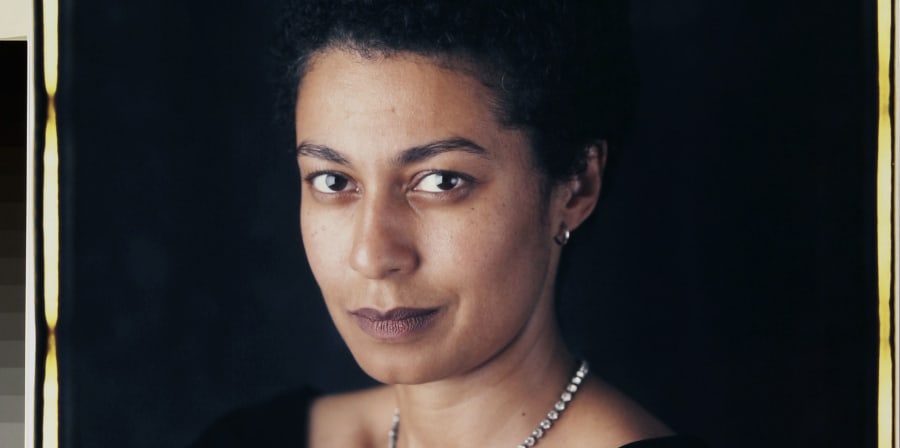Deborah Cherry: On Putting Diversity Centre Frame

If photographic artist Maud Sulter taught us anything, it was to be bold and adjust the focus to improve diversity in art, says Deborah Cherry.
With Parliament looking at diversity in TV, there is no better time to be looking at the works of Maud Sulter (1960-2008). The daring and defiant award-winning artist and writer, curator and gallerist of Ghanaian and Scottish heritage, literally and figuratively put black women in the centre of the frame. Deborah Cherry, Professor of Art History at UAL, tells us about the research and collaboration which was the foundation for the series of recent and forthcoming exhibitions on Maud Sulter and on meeting the artist herself:
In the 1980s Black artists experienced considerable discrimination as white critics frequently ignored their artwork and mainstream art institutions often excluded it.
While organising Painting Women, an exhibition on Victorian women artists at Rochdale in the later 1980s, I had the honour of meeting Maud Sulter. In her usual bold style, she approached me and asked “why are you working on Victorian women, when you could be writing about me?”
It was a good point and this was the trigger which would direct my research for years to come. As a result of this research and artistic collaborations, the first Maud Sulter exhibitions outside Scotland since her death have taken place and will continue as part of a series across the UK this year and next, putting Maud Sulter - and black women in the arts more widely - back in the picture.
The research project brings together TrAIN, UAL's research centre for transnational art, two leading photography galleries, Street Level Photoworks in Glasgow and Autograph-ABP in London, and the artist and activist Ajamu. Several exhibitions have now taken place, and we have published the first full-length book on Maud Sulter's art and writing.
One of Maud’s most inspiring works was Les Bijoux, dramatic images of the artist herself as Jeanne Duval in which a range of emotions play over her face, interrogating the passions that arise in a mature, tumultuous long-term relationship. She wrote of her interest in this Haitian-born actress and dancer of mixed French and black African ancestry best known as the muse and companion of poet Charles Baudelaire: “My ongoing visual fascination with Jeanne Duval began in 1988 with a visceral response to a [Felix] Nadar photograph captioned Unknown Woman. There she stared at me willing me to give her a name, an identity, a voice. So for over a decade I have been image making with her in mind, from Calliope in Zabat, 1989 to Les Bijoux, 2002.”
We all have a part to play in diversity
UAL is at the forefront of rewriting art's histories to address the achievements of Black artists, with the major research project, Black Artists and Modernism, led by Professor Sonia Boyce MBE RA. Over the past decade there have been strong research interests in reappraising the black arts movement of the 1980s. The work of black artists of the 1980s contained powerful critiques of western art histories and their institutions, they produced images and films that created new powerful images of black people that countered stereotypes and challenged marginalisation.
Three key themes emerged from our research on Maud Sulter:
- Maud Sulter's own statement that she was passionately interested in 'putting Black women back in the centre of the frame'.
- Her declared interests in black women whose histories have been erased or neglected.
- The many connections that she made between Africa and Europe.
Our aim has been to showcase key chapters in her multilayered photographic art practice: works from the critically acclaimed Zabat (1989), her award winning series of majestic allegorical portraits of contemporary black women writers, artists, and musicians who are cast as the muses and from her major series such as Hysteria, Syrcas and Les Bijoux.
The collaboration with Ajamu, Autograph ABP, Street Level Photoworks and TrAIN, UAL's research centre for the study of transnational art, identity and nation, created an inter-cultural exchange for curating the Maud Sulter exhibition. UAL students and alumni such as the distinguished photographic artist Ingrid Pollard (an LCC alumna), photographic artist Marcia Michael, (currently doing her PhD at LCC), and artist and curator, Marlene Smith (the research manager of Black Artists and Modernism, and also a PhD student at UAL), contributed to what was affectionately known as ‘Team Maud’. Paul Bailey, Course Leader for MA Graphic Media Design at LCC, designed our really beautiful book. The research project has been supported a generous grant from Arts Council England together with partnership and university funding.
Continuing her passion
When the Maud Sulter exhibition ‘Passion’ was showing at Impressions Gallery in Bradford, one of the leading UK contemporary photography galleries, we hoped it would help cement her name in our cultural history. As Robert Clark writing in the Guardian said of the show: “this exhibition should restore her rightful standing as a significant figure of late-20th-century issue-based photo-art.”
Over 5,000 people visited the Maud Sulter exhibition Syrcas at Rivington Place, London between 15 January and 2 April 2016, and with her Bradford exhibition and other future shows, her work and achievements are coming back into visibility, and most importantly, more people are getting to know and enjoy her art.
Deborah Cherry
Professor Art History and Theory
University of the Arts London
Central Saint Martins